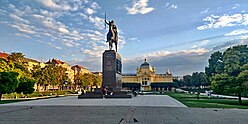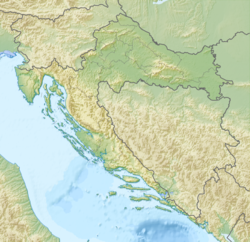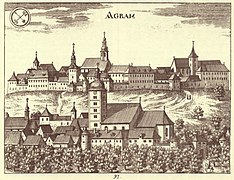A | B | C | D | E | F | G | H | CH | I | J | K | L | M | N | O | P | Q | R | S | T | U | V | W | X | Y | Z | 0 | 1 | 2 | 3 | 4 | 5 | 6 | 7 | 8 | 9
Zagreb | |
|---|---|
Capital city and county | |
| Grad Zagreb City of Zagreb | |
Stone Gate in the Upper Town Cibona and HOTO towers Art Pavilion and Monument of the King Tomislav of Croatia | |
|
| |
 | |
 The city of Zagreb in Croatia | |
| Coordinates: 45°48′47″N 15°58′39″E / 45.81306°N 15.97750°E | |
| Country | |
| County | City of Zagreb |
| RC diocese | 1094 |
| Free royal city | 1242 |
| Unified | 1850 |
| Subdivisions | 17 city districts 218 local committees 70 settlements |
| Government | |
| • Type | Mayor-Council |
| • Mayor | Tomislav Tomašević (Možemo!) |
| • City Assembly | 48 members |
| Area | |
| • City | 641.2 km2 (247.6 sq mi) |
| • Urban | 305.8 km2 (118.1 sq mi) |
| Elevation | 158 m (518 ft) |
| Highest elevation | 1,035 m (3,396 ft) |
| Lowest elevation | 122 m (400 ft) |
| Population (2021)[3] | |
| • City | 767,131 |
| • Density | 1,200/km2 (3,100/sq mi) |
| • Urban | 663,592 |
| • Urban density | 2,200/km2 (5,600/sq mi) |
| • Metro | 1,217,150 |
| Demonym(s) | Zagreber (en) Zagrepčanin (hr, male) Zagrepčanka (hr, female) Purger (informal, jargon) |
| GDP | |
| • City | €20.284 billion |
| • Per capita | €25,100 |
| Time zone | UTC+1 (CET) |
| • Summer (DST) | UTC+2 (CEST) |
| Postal code | HR-10 000, HR-10 010, HR-10 020, HR-10 040, HR-10 090 |
| Area code | +385 1 |
| Vehicle registration | ZG |
| HDI (2021) | 0.916[6] – very high |
| Website | zagreb |
Zagreb (/ˈzɑːɡrɛb/ ZAH-greb[7] Croatian: [zǎːɡreb] [a])[9] is the capital and largest city of Croatia.[10] It is in the north of the country, along the Sava river, at the southern slopes of the Medvednica mountain. Zagreb stands near the international border between Croatia and Slovenia at an elevation of approximately 158 m (518 ft) above sea level.[11] At the 2021 census, the city itself had a population of 767,131,[3] while the population of Zagreb urban agglomeration is slightly above one million people.
Zagreb is a city with a rich history dating from Roman times. The oldest settlement in the vicinity of the city was the Roman Andautonia, in today's Šćitarjevo.[12] The historical record of the name "Zagreb" dates from 1134, in reference to the foundation of the settlement at Kaptol in 1094. Zagreb became a free royal city in 1242.[13] In 1851, Janko Kamauf became Zagreb's first mayor.[14] Zagreb has special status as a Croatian administrative division—it comprises a consolidated city-county (but separate from Zagreb County),[15] and is administratively subdivided into 17 city districts.[16] Most of the city districts lie at a low elevation along the valley of the river Sava, but northern and northeastern city districts, such as Podsljeme[17] and Sesvete[18] districts are situated in the foothills of the Medvednica mountain,[19] making the city's geographical image quite diverse. The city extends over 30 km (19 mi) east-west and around 20 km (12 mi) north-south.[20][21] Zagreb ranks as a global city, with a 'Beta-' rating from the Globalization and World Cities Research Network.[22]
The transport connections, the concentration of industry, scientific, and research institutions and industrial tradition underlie its leading economic position in Croatia.[23][24][25] Zagreb is the seat of the central government, administrative bodies, and almost all government ministries.[26][27][28] Almost all of the largest Croatian companies, media, and scientific institutions have their headquarters in the city. Zagreb is the most important transport hub in Croatia: here Central Europe, the Mediterranean and Southeast Europe meet, making the Zagreb area the centre of the road, rail and air networks of Croatia. It is a city known for its diverse economy, high quality of living, museums, sporting, and entertainment events. Major branches of Zagreb's economy include high-tech industries and the service sector.
Name
The etymology of the name Zagreb is unclear. It was used for the united city only from 1852, but it had been in use as the name of the Zagreb Diocese since the 12th century and was increasingly used for the city in the 17th century.[29] The name is first recorded in a charter by Felician, Archbishop of Esztergom, dated 1134, mentioned as Zagrabiensem episcopatum.[30]
The name is probably derived from Proto-Slavic word *grębъ which means "hill" or "uplift". An Old Croatian reconstructed name *Zagrębъ is manifested through the city's former German name, Agram.[31] Some linguists (e.g. Nada Klaić, Miroslav Kravar) propose a metathesis of *Zabreg, which would originate from Old Slavic breg (see Proto-Slavic *bergъ) in the sense of "riverbank", referring to River Sava. This metathesis has been attested in Kajkavian,[32] but the meaning of "riverbank" is lost in modern Croatian and folk etymology associates it instead with breg "hill", ostensibly referring to Medvednica. Hungarian linguist Gyula Décsy similarly uses metathesis to construct *Chaprakov(o), a putative Slavicisation of a Hungarian hypocorism for "Cyprian", similar to the etymology of Csepreg, Hungary.[33] The most likely derivation is *Zagrębъ in the sense of "embankment" or "rampart", i.e. remains of the 1st millennium fortifications on Grič.[32][31]
In Middle Latin and Modern Latin, Zagreb is known as Agranum (the name of an unrelated Arabian city in Strabo),[citation needed] Zagrabia or Mons Graecensis (also Mons Crecensis, in reference to Grič (Gradec)).
The most common folk etymology derives the name of the city has been from the verb stem za-grab-, meaning "to scoop" or "to dig". A folk legend illustrating this derivation, attested but discarded as a serious etymology by Ivan Tkalčić, ties the name to a drought of the early 14th century, during which Augustin Kažotić (c. 1260–1323) is said to have dug a well which miraculously produced water.[34] In another legend,[35][36][37][38][39] a city governor is thirsty and orders a girl named Manda to "scoop" water from the Manduševac well (nowadays a fountain in Ban Jelačić Square), using the imperative: Zagrabi, Mando! ("Scoop, Manda!").[40]
History

The oldest known settlement located near present-day Zagreb, the Roman town of Andautonia, now Ščitarjevo, existed between the 1st and the 5th centuries AD.[41]
The first recorded appearance of the name "Zagreb" dates from 1094, at which time the city existed as two different city centers: the smaller, eastern Kaptol, inhabited mainly by clergy and housing Zagreb Cathedral, and the larger, western Gradec, inhabited mainly by craftsmen and merchants. In 1851 the Ban of Croatia, Josip Jelačić, united Gradec and Kaptol; the name of the main city square, Ban Jelačić Square honors him.[42]
While Croatia formed part of Yugoslavia (1918 to 1991), Zagreb remained an important economic centre of that country, and was the second largest city. After Croatia declared independence from Yugoslavia in 1991, the Parliament of the Republic of Croatia (Croatian: Sabor Republike Hrvatske) proclaimed Zagreb as the capital of the Republic of Croatia.[43]
Early Zagreb
The history of Zagreb dates as far back as 1094 A.D. when the Hungarian King Ladislaus, returning from his campaign against the Kingdom of Croatia, founded a diocese. Alongside the bishop's see, the canonical settlement Kaptol developed north of Zagreb Cathedral, as did the fortified settlement Gradec on the neighbouring hill, with the border between the two formed by the Medveščak stream.[44] Today the latter is Zagreb's Upper Town (Gornji Grad) and is one of the best-preserved urban nuclei in Croatia. Both settlements came under Tatar attack in 1242.[45] As a sign of gratitude for offering him a safe haven from the Tatars, the Croatian and Hungarian King Béla IV granted Gradec the Golden Bull of 1242, which gave its citizens exemption from county rule and autonomy, as well as their own judicial system.[46][47]
The relationship between Kaptol and Gradec throughout history
The development of Kaptol began in 1094 after the foundation of the diocese, while the growth of Gradec began after the Golden Bull was issued in 1242. In the history of the city of Zagreb, there have been numerous conflicts between Gradec and Kaptol, mainly due to disputed issues of rent collection and due to disputed properties.
The first known conflicts took place in the middle of the 13th century and continued with interruptions until 1667. Because of the conflict, it was recorded that the Bishop of Kaptol excommunicated the residents of Gradec twice.
In the conflicts between Gradec and Kaptol, there were several massacres of the citizens, destruction of houses and looting of citizens. In 1850, Gradec and Kaptol, with surrounding settlements, were united into a single settlement, today's city of Zagreb.[48][49][50][51][52]
16th to 18th centuries
There were numerous connections between the Kaptol diocese and the free sovereign town of Gradec for both economic and political reasons, but they were not known as an integrated city, even as Zagreb became the political center, and the regional Sabor (Latin: Congregatio Regnorum Croatiae, Dalmatiae et Slavoniae) representing Croatia, Slavonia and Dalmatia, first convened at Gradec. Zagreb became the Croatian capital in 1557, with city also being chosen as the seat of the Ban of Croatia in 1621 under ban Nikola IX Frankopan.[53]
At the invitation of the Croatian Parliament, the Jesuits came to Zagreb and built the first grammar school,[54] the St. Catherine's Church (built 1620-1632[55]) and monastery. In 1669, they founded an academy where philosophy, theology, and law were taught, the forerunner of today's University of Zagreb.
During the 17th and 18th centuries, Zagreb was badly devastated by fire and by the plague. In 1776, the royal council (government) moved from Varaždin to Zagreb and during the reign of the Emperor Joseph II Zagreb became the headquarters of the Varaždin and Karlovac general command.[56]
19th to mid-20th century
-
Ban Jelačić Square in Zagreb under the Habsburgs, before the 1880 Zagreb earthquake
-
The Zagreb Cathedral renovated according to designs of Hermann Bollé, between 1902 and 1906
-
Zagreb 1930s
-
Starčević square, first half of the 20th century
-
Bronze map of the historic center of Zagreb
In the 19th century, Zagreb was the center of the Croatian National Revival and saw the foundation of important cultural and historic institutions. In 1850, the town was united under its first mayor – Janko Kamauf.[56]
The first railway line to connect Zagreb with Zidani Most and Sisak opened in 1862 and in 1863 Zagreb received a gasworks. The Zagreb waterworks opened in 1878.
After the 1880 Zagreb earthquake, up to the 1914 outbreak of World War I, development flourished and the town received the characteristic layout which it has today. The first horse-drawn tram dated from 1891. The construction of railway lines enabled the old suburbs to merge gradually into Donji Grad, characterized by a regular block pattern that prevails in Central European cities. This bustling core includes many imposing buildings, monuments, and parks as well as a multitude of museums, theatres, and cinemas. An electric-power plant was built in 1907.
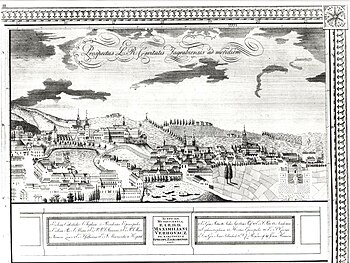
Since 1 January 1877, the Grič cannon fires daily from the Lotrščak Tower on Grič to mark midday.
The first half of the 20th century saw a considerable expansion of Zagreb. Before World War I, the city expanded and neighborhoods like Stara Peščenica in the east and Črnomerec in the west grew up. The Rokov perivoj neighbourhood, noted for its Art Nouveau features, was established at the start of the century.[57]
After the war, working-class districts such as Trnje emerged between the railway and the Sava, whereas the construction of residential districts on the hills of the southern slopes of Medvednica was completed between the two World Wars.
In the 1920s, the population of Zagreb increased by 70 percent – the largest demographic boom in the history of the town. In 1926, the first radio station in the region began broadcasting from Zagreb, and in 1947 the Zagreb Fair opened.[56]
During World War II, Zagreb became the capital of the Independent State of Croatia (1941–1945), which was backed by Nazi Germany and by the Italians. The history of Zagreb in World War II became rife with incidents of régime terror and resistance sabotage - the Ustaša régime had thousands of people executed during the war in and near the city. Partisans took the city at the end of the war. From 1945 until 1990, Zagreb functioned as the capital of the Socialist Republic of Croatia, one of the six constituent socialist republics of the Socialist Federal Republic of Yugoslavia.
Contemporary era
The area between the railway and the Sava river witnessed a new construction-boom after World War II. After the mid-1950s, construction of new residential areas south of the Sava river began, resulting in Novi Zagreb (Croatian for New Zagreb), originally called "Južni Zagreb" (Southern Zagreb).[58] From 1999 Novi Zagreb has comprised two city districts: Novi Zagreb – zapad (New Zagreb – West) and Novi Zagreb – istok (New Zagreb – East)
The city also expanded westward and eastward, incorporating Dubrava, Podsused, Jarun, Blato, and other settlements.
The cargo railway hub and the international airport (Pleso) were built south of the Sava river. The largest industrial zone (Žitnjak) in the south-eastern part of the city, represents an extension of the industrial zones on the eastern outskirts of the city, between the Sava and the Prigorje region. Zagreb hosted the Summer Universiade in 1987.[56] This event initiated the creation of pedestrian-only zones in the city centre and extensive new sport infrastructure, lacking until then, all around the city.[citation needed]
During the 1991–1995 Croatian War of Independence, the city saw some sporadic fighting around its JNA army barracks, but escaped major damage. In May 1995, it was targeted by Serb rocket artillery in two rocket attacks which killed seven civilians and wounded many.
An urbanized area connects Zagreb with the surrounding towns of Zaprešić, Samobor, Dugo Selo, and Velika Gorica. Sesvete was the first and the closest area to become a part of the agglomeration and is already included in the City of Zagreb for administrative purposes and now forms the easternmost city district.[59]
In 2020 the city experienced a 5.5 magnitude earthquake, which damaged various buildings in the historic downtown area. The city's iconic cathedral lost the cross off of one of its towers. This earthquake was the strongest one to affect the city since the destructive 1880 Zagreb earthquake.
Geography
Climate
The climate of Zagreb is classified as an oceanic climate (Köppen: Cfb), bordering a humid continental climate (Dfb).
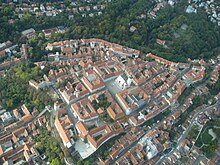

Zagreb has four separate seasons. Summers are generally warm, sometimes hot. In late May it gets significantly warmer, temperatures start rising and it often becomes very warm or even hot with occasional afternoon and evening thunderstorms. Heatwaves can occur but are short-lived. Temperatures rise above 30 °C (86 °F) on average 14.6 days each summer. During summertime, rainfall is abundant and it mainly falls during thunderstorms. With 840 mm of precipitation per year, Zagreb is Europe's ninth wettest capital, receiving less precipitation than Luxembourg but more than Brussels, Paris or London. Compared to these cities, however, Zagreb has fewer rainy days, but the annual rainfall is higher due to heavier showers occurring mainly in late spring and summer. Autumn in its early stage often brings pleasant and sunny weather with occasional episodes of rain later in the season. Late autumn is characterized by a mild increase in the number of rainy days and a gradual decrease in daily temperature averages. Morning fog is common from mid-October to January, with northern city districts at the foothills of the Medvednica mountain as well as south-central districts along the Sava river being more prone to longer fog accumulation.
Winters are relatively cold, bringing overcast skies and a precipitation decrease pattern. February is the driest month, averaging 39 mm of precipitation. On average there are 29 days with snowfall, with the first snow usually falling in early December. However, in recent years, the number of days with snowfall in wintertime has decreased considerably. Spring is characterized by often pleasant but changeable weather. As the season progresses, sunny days become more frequent, bringing higher temperatures. Sometimes cold spells can occur as well, mostly in the season's early stages. The average daily mean temperature in the winter is around 1 °C (34 °F) (from December to February) and the average temperature in the summer is 20 °C (68.0 °F).[60] The highest recorded temperature at the Maksimir weather station was 40.4 °C (104.7 °F) in July 1950, and lowest was −27.3 °C (−17.1 °F) in February 1956.[61] A temperature of −30.5 °C (−22.9 °F) was recorded on the since defunct Borongaj Airfield in February 1940.[62]







